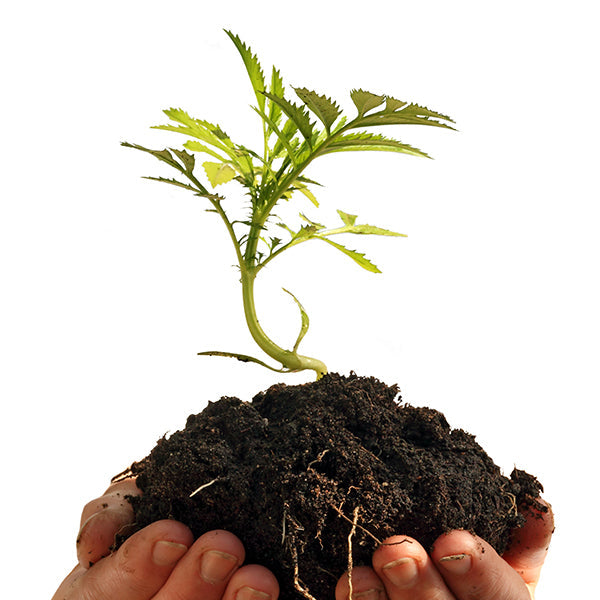
The Environmental Protection Agency (EPA) also acknowledges that: “All soils contain trace levels of metals. The presence of metals in soil is, therefore, not indicative of contamination. The concentration of metals in uncontaminated soil is primarily related to the geology of the parent material from which the soil was formed. Depending on the local geology, the concentration of metals in a soil may exceed the
As such, ANY vegetation (be it fruits, vegetables, grains or legumes) grown directly in soil or surrounding bodies of water, will absorb these naturally-occurring metals just as they would other nutrients like zinc or iron. (The same goes to the rice used to make our rice protein.) This affects both organic and conventionally grown crops. Additionally, certain plants like those grown beneath the soil (e.g. potatoes) and leafy greens (e.g. lettuce and spinach) tend to absorb more heavy metals than others. If plants grown directly in soil are used to feed livestock (cows, chickens, etc.) then the metals will leech into animal-based food or animal-based products as well. In the ocean, seafood like tuna absorbs the mercury that the ocean gets from the Earth and sea algae/vegetables will absorb any heavy metals directly on the seabed or ocean.
Drinking water obtained from natural springs could also contain some of these heavy metals. In fact, a 2011 study in California found 14 heavy metals in six different sources of bottled natural spring water(6). All concentrations were within federal and state maximum contaminant levels, except for arsenic which exceeded California public health goal levels in all six sources. Federal health agencies (like USDA or ATSDR) recognize that food (especially plant-based) is a major source of heavy metal exposure.
In fact, every few years the USDA/FDA tests the metal/mineral content of hundreds of foods and fresh produce and publishes this information for public viewing. For example, here is some data from 2007:
| Max. Amounts of Lead, Arsenic, Cadmium found in commonly consumed Foods (7) | |||
| Lead | Arsenic | Cadmium | |
| Spinach, fresh, boiled (180g)1 cup | 11.5 mcg | 7.7 mcg | 94.3 mcg |
| Cucumber, raw (52g) ½ cup | 1.6 mcg | 1.3 mcg | 0.4 mcg |
| Strawberries, raw (72g) ½ cup | 1.2 mcg | 0.8 mcg | 4.7 mcg |
| Avocado, raw (75g) ½ cup | 3.0 mcg | 2.8 mcg | 8.0 mcg |
| Collards, fresh, boiled (190g) 1 cup | 25.8 mcg | 2.7 mcg | 23.2 mcg |
| Asparagus, fresh, boiled (180g) 1 cup | 2.5 mcg | – | 25.0 mcg |
| Iceberg lettuce, raw (72g) 1 cup | 0.4 mcg | 1.0 mcg | 23.3 mcg |
| White potato baked w/ skin (138g) 1 cup | 2.8 mcg | 5.8 mcg | 15.5 mcg |
| Broccoli, fresh, boiled (156g) 1 cup | 2.2 mcg | – | 4.7 mcg |
Surprisingly, some of the highest contents are found in some of the most nutritious foods. Some of these levels far exceed "safety levels" set forth by federal standards. This goes without saying, the more plant-based foods you consume, the more heavy metals you are probably exposed to.
So why is this not a public health concern?? To date, a growing body of evidence has indicated that the benefits of consuming plant-based foods FAR OUTWEIGH any consequences attributed to heavy metals. Consuming metals is inevitable, and in spite of this vegans and vegetarians are known to be some of the healthiest and longest-living populations. Research indicates various factors affect the absorption of naturally occurring metals and that the body is able to act as a natural filter to these offending substances!
By: Scarlett Full, in-house Dietitian/Nutritionist
References:
1. Dobson S. “Environmental Health Criteria for Cadmium – Environmental Aspects.” International Programme on Chemical Safety, World Health Organization. 1992.
2. Toxicological profile for Cadmium. Agency for Toxic Substances and Disease Registry, US Department of Health and Human Services. 2012. Available at: http://www.atsdr.cdc.gov/toxprofiles/tp.asp?id=48&tid=15
3. "Environmental Health Criteria for Lead.” International Programme on Chemical Safety, World Health Organization. 1977.
4. Toxicological Profile for Lead. Agency for Toxic Substances and Disease Registry, US Department of Health and Human Services. 2007. Available at: http://www.atsdr.cdc.gov/toxprofiles/tp.asp?id=96&tid=22
5. McLean JE & Bledsoe BE. Behavior of metals in soils. Office of Research and Development, United States Environmental Protection Agency. October 1992. Available at: http://www.epa.gov/superfund/remedytech/tsp/download/issue14.pdf
6. Sullivan MJ, Leavey S. Heavy metals in natural bottled spring water. J Environ Health. 2011 Jun; 73(10):8-13. 7. Total Diet Study Statistics on Element Results. 2007, Center for Food Safety and Applied Nutrition, US Food and Drug Adminstration. Available here: http://www.fda.gov/downloads/Food/FoodScienceResearch/TotalDietStudy/UCM243059.pdf
